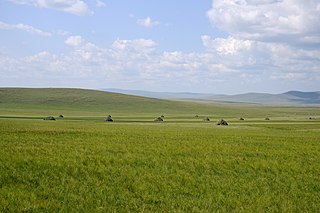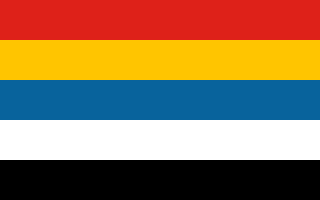See also
- Chinese Mongolian, also known as ethnic Chinese in Mongolia
Mongolian Chinese usually refer to ethnic Mongols in China.
Mongolian Chinese might also refer to:

The Mongols are an East Asian ethnic group native to Mongolia, Inner Mongolia in China and the Buryatia Republic of the Russian Federation. The Mongols are the principal member of the large family of Mongolic peoples. The Oirats in Western Mongolia as well as the Buryats and Kalmyks of Russia are classified either as distinct ethno-linguistic groups or subgroups of Mongols.

Inner Mongolia, officially the Inner Mongolia Autonomous Region (IMAR), is an autonomous region of the People's Republic of China. Its border includes most of the length of China's border with the country of Mongolia. Inner Mongolia also accounts for a small section of China's border with Russia. Its capital is Hohhot; other major cities include Baotou, Chifeng, Tongliao, and Ordos.

Outer Mongolia was the name of a territory in the Manchu-led Qing dynasty of China from 1691 to 1911. It corresponds to the modern-day independent state of Mongolia and the Russian republic of Tuva. The historical region gained de facto independence from Qing China during the Xinhai Revolution.
Mongolian is the official language of Mongolia and both the most widely spoken and best-known member of the Mongolic language family. The number of speakers across all its dialects may be 5.2 million, including the vast majority of the residents of Mongolia and many of the ethnic Mongol residents of the Inner Mongolia Autonomous Region of the People's Republic of China. In Mongolia, Khalkha Mongolian is predominant, and is currently written in both Cyrillic and the traditional Mongolian script. In Inner Mongolia, it is dialectally more diverse and written in the traditional Mongolian script. However, Mongols in both countries often use the Latin script for convenience on the Internet.
The Khalkha have been the largest subgroup of Mongol people in modern Mongolia since the 15th century. The Khalkha, together with Chahars, Ordos and Tumed, were directly ruled by Borjigin khans until the 20th century; unlike the Oirats, who were ruled by Dzungar nobles or the Khorchins, who were ruled by Qasar's descendants.
Banner is a type of administrative division, and may more specifically refer to:
Chinese Mongolians can be subdivided into three groups: Mongolian citizens of ethnic Chinese background, temporary residents with Chinese citizenship, and permanent residents with Chinese citizenship. Mongolia's 1956 census counted ethnic Chinese as 1.9% of the population; the United States government estimated their proportion to be 2% in 1987, or roughly 40,000 people. The 2000 census showed 1,323 permanent residents of Chinese descent; this figure does not include naturalised citizens, temporary residents, nor illegal immigrants. Illegal immigrants from China were estimated at 10,000 in the 1990s; some use Mongolia as a transit point into Russia.

Mongols in China or Mongolian Chinese are ethnic Mongols who were integrated into the nation-building of the Republic of China (1912–1949) after the fall of Qing Empire (1636–1911). Those not integrated broke away in the Mongolian Revolution of 1911 and again in 1921. The Republic of China recognized Mongols to be part of the Five Races Under One Union. Its successor, the People's Republic of China (1949—present), recognized Mongols to be one of the 55 ethnic minorities in China.

Islam in Mongolia is practiced by approximately 3 to 5% of the population. It is practised by the ethnic Kazakhs of Bayan-Ölgii Province and Khovd Province aimag in western Mongolia. In addition, a number of small Kazakh communities can be found in various cities and towns spread throughout the country. Islam is also practiced by the smaller communities of Khotons and Uyghurs.
Mongols are one or several ethnic groups largely located in Russia, Mongolia and China.

Pan-Mongolism is an irredentist idea that advocates cultural and political solidarity of Mongols. The proposed territory, called "Greater Mongolia", also known as which means "Whole Mongolia" usually includes the independent state of Mongolia, the Chinese regions of Inner Mongolia and Dzungaria, and the Russian republic of Buryatia. Sometimes the autonomous republic Tuva, the Altai Republic and parts of Zabaykalsky Krai and Irkutsk Oblast are included as well. As of 2006, all areas in Greater Mongolia except Mongolia have non-Mongol majorities.

Mongolia under Qing rule was the rule of the Manchu-led Qing dynasty of China over the Mongolian Plateau, including the four Outer Mongolian aimags and the six Inner Mongolian aimags from the 17th century to the end of the dynasty. The term "Mongolia" is used here in the broader historical sense, and includes an area much larger than the modern-day state of Mongolia. Ligdan saw much of his power weakened due to the disunity of the Mongol tribes. He was subsequently defeated by the Later Jin dynasty and died soon afterwards. His son Ejei handed the Yuan imperial seal over to Hong Taiji in 1635, thus ending the rule of the Northern Yuan dynasty in Inner Mongolia. However, the Khalkha Mongols in Outer Mongolia continued to rule until they were overrun by the Dzungar Khanate in 1690, and they submitted to the Qing dynasty in 1691.

The Kharchin, or Kharachin, is a subgroup of the Mongols residing mainly in North-western Liaoning and Chifeng, Inner Mongolia. There are Khalkha-Kharchin Mongols in Dorno-Gobi Province and in Ulaanbaatar, Mongolia.

Zhonghua minzu is a political term in modern Chinese nationalism related to the concepts of nation-building, ethnicity, and race in the Chinese nationality.
The Jindandao incident refers to a rebellion by a Han Chinese secret society called Jindandao, who rose in revolt in Inner Mongolia in November 1891 and massacred 150,000–500,000 Mongols before being suppressed by government troops in late December. The revolt devastated Mongol communities in the southeastern borderland and forced many Mongols to take refuge in northern banners. This massacre was later dubbed an incident by Chinese officials.

Mongolian shamanism, more broadly called the Mongolian folk religion, or occasionally Tengerism, refers to the animistic and shamanic ethnic religion that has been practiced in Mongolia and its surrounding areas at least since the age of recorded history. In the earliest known stages it was intricately tied to all other aspects of social life and to the tribal organization of Mongolian society. Along the way, it has become influenced by and mingled with Buddhism. During the socialist years of the twentieth century, it was heavily repressed, but has since made a comeback.

Yun is a Chinese surname, listed 41st in the Song dynasty classic text Hundred Family Surnames.

Religion in Inner Mongolia is characterised by the diverse traditions of Mongolian-Tibetan Buddhism, Chinese Buddhism, the Chinese traditional religion including the traditional Chinese ancestral religion, Taoism, Confucianism and folk religious sects, and the Mongolian native religion. The region is inhabited by a majority of Han Chinese and a substantial minority of Southern Mongols, so that some religions follow ethnic lines.
Anti-Mongol sentiment has been prevalent throughout history, often perceiving the Mongols to be a barbaric and uncivilized people with a lack of intelligence or civilized culture.

The 2020 Inner Mongolia protests was a protest caused by a curriculum reform imposed on ethnic schools by China's Inner Mongolia Department of Education. The two-part reform replaces Mongolian with Standard Mandarin as the medium of instruction in three particular subjects and replace three regional textbooks, printed in Mongolian script, by the nationally-unified textbook series edited by the Ministry of Education, written in Standard Mandarin. On a broader scale, the opposition to the curriculum change reflects ethnic issues in China and the decline of regional language education in China.